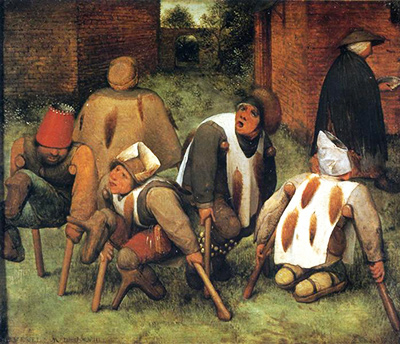Painted in 1568 as an oil on panel, The Beggars (also known as The Cripples) is a fascinating image.
The original painting was gifted to the Louvre in 1892 and remains on exhibition there.
Although Bruegel was known for depicting everyday scenes of the times, this image has continued to puzzle art historians.
Many theories have been put forward to explain Bruegel's image of the five "pitiful cripples" and a lone woman carrying a begging bowl but none have been fully proven.
Some experts have suggested that the various hats that the beggars wear - the cardboard crown, the bishops Mitre the peasant cap and the bourgeoisie beret depict the different classes in society and the piece is a satire.
Others have been interested in Bruegel's use of the foxtails that are pinned to the figures. In Bruegel's time, Europeans had little sympathy for the plight of beggars and the foxtails could be simply symbols of ridicule.
However another interpretation suggests that the foxtails could refer to the "Gueux", a rebel party who opposed Philip II of Spain's rule. One of the figures wears bells around his stumps like a jester.
Again, this could simply show ridicule, but it could also be an allusion to the annual Beggar's Feast Day, whereby beggars would sing as they begged on the Monday after Epiphany.
The fact that the figures are depicted beside a wall which opens out to a view of the countryside may reflect their position "on the fringe of society".
Bruegel's painting of The Beggars is a fascinating image and insight into history and society at that time.
Though the Beggars are portrayed in a pathetic and unsympathetic manner, the composition is skillful and captivating. A remarkable piece of social commentary, some of which remains unsaid.




